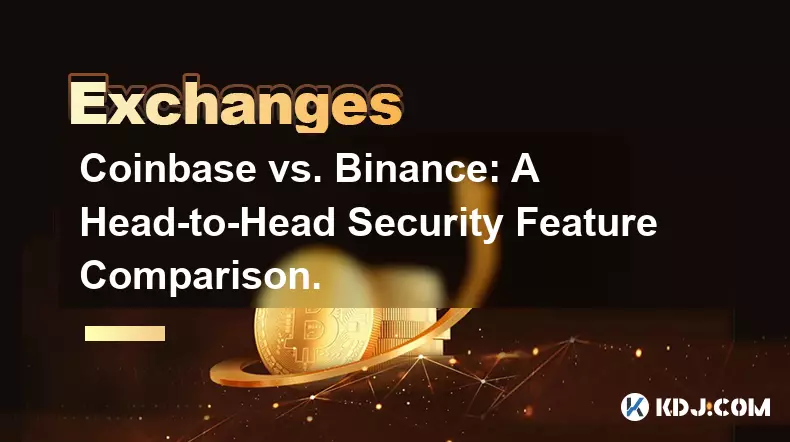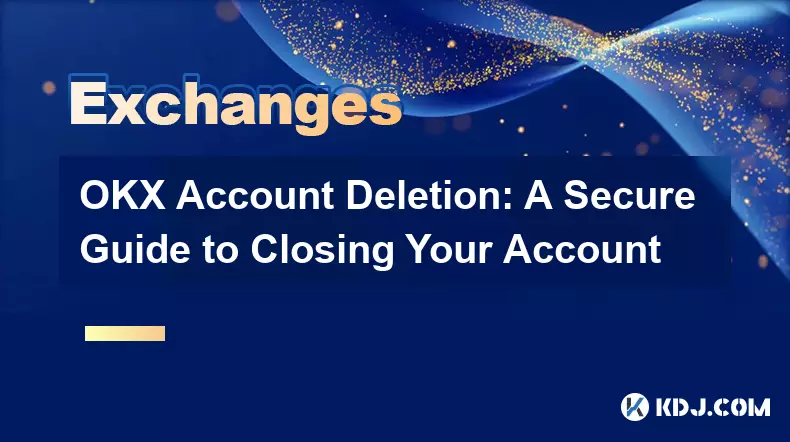-
 bitcoin
bitcoin $102877.190955 USD
1.88% -
 ethereum
ethereum $3430.435064 USD
4.52% -
 tether
tether $0.999264 USD
-0.05% -
 xrp
xrp $2.307310 USD
4.49% -
 bnb
bnb $987.740692 USD
3.82% -
 solana
solana $161.947760 USD
3.97% -
 usd-coin
usd-coin $0.999712 USD
-0.05% -
 tron
tron $0.292810 USD
2.93% -
 dogecoin
dogecoin $0.179738 USD
10.70% -
 cardano
cardano $0.580716 USD
8.75% -
 hyperliquid
hyperliquid $42.463448 USD
8.40% -
 chainlink
chainlink $15.763437 USD
7.05% -
 zcash
zcash $649.595636 USD
17.21% -
 bitcoin-cash
bitcoin-cash $511.610261 USD
7.19% -
 stellar
stellar $0.292537 USD
7.91%
Coinbase vs. Binance: A Head-to-Head Security Feature Comparison.
Coinbase enforces mandatory 2FA, biometric login, and insurance for online assets, while Binance allows 2FA bypassing and lacks crypto insurance, giving Coinbase an edge in security.
Nov 04, 2025 at 04:54 pm

Coinbase vs. Binance: A Head-to-Head Security Feature Comparison
User Authentication Mechanisms
1. Coinbase enforces mandatory two-factor authentication (2FA) using authenticator apps, SMS, or security keys like YubiKey. Users cannot disable 2FA once enabled, ensuring persistent protection.
2. Binance also supports 2FA via Google Authenticator and SMS, but allows users to temporarily bypass it under certain conditions, which introduces potential vulnerabilities if not managed carefully.
3. Coinbase integrates biometric login options on mobile devices, including Face ID and fingerprint recognition, offering seamless yet secure access without compromising safety.
4. Binance provides similar biometric features but only after initial 2FA setup, creating an extra layer that may deter some users despite improved defense against unauthorized logins.
5. Both platforms support hardware security key integration, though Coinbase has broader compatibility with FIDO U2F standards across more device types.
Funds Protection and Custody Models
1. Coinbase stores approximately 98% of user assets in cold storage, with the remaining 2% in hot wallets protected by multi-signature technology and real-time monitoring systems.
2. Binance uses a Secure Asset Fund for Users (SAFU), allocating 10% of trading fees into a reserve fund designed to cover losses during extreme security breaches.
3. Coinbase carries crime insurance covering digital assets held in online storage, a feature not replicated by Binance, giving Coinbase an edge in financial risk mitigation.
4. Binance employs a multisignature wallet system for cold storage, requiring multiple approvals for fund movement, reducing the likelihood of insider threats or compromised keys.
5. Coinbase’s custodial model is regulated under U.S. financial laws, subjecting it to audits and compliance checks that enhance transparency and accountability in asset management.
Platform Infrastructure and Threat Detection
1. Coinbase operates a proprietary security engine that monitors transactions in real time, flagging suspicious activities based on behavioral analytics and machine learning algorithms.
2. Binance utilizes an AI-driven Anti-Phishing system that detects and blocks fraudulent emails and domains attempting to mimic official communications.
3. Coinbase runs regular third-party penetration tests and offers a public bug bounty program through platforms like HackerOne, incentivizing ethical hackers to identify vulnerabilities.
4. Binance maintains its own internal red team that conducts continuous simulated attacks to evaluate system resilience, complemented by external audits from cybersecurity firms.
5. Both exchanges employ IP whitelisting, withdrawal address freezing, and session timeout policies, though Coinbase enforces stricter default settings that require manual approval for new device logins.
Regulatory Compliance and Data Privacy
1. Coinbase adheres to Know Your Customer (KYC) and Anti-Money Laundering (AML) regulations enforced by U.S. authorities, conducting thorough identity verification before account activation.
2. Binance implemented enhanced KYC requirements globally after regulatory pressure in 2021, now requiring photo identification and proof of residence for most users.
3. Coinbase encrypts user data at rest and in transit using AES-256 encryption, with access restricted to authorized personnel only, minimizing exposure to data leaks.
4. Binance applies end-to-end encryption for sensitive operations but has faced criticism in the past for inconsistent enforcement across regional subsidiaries.
5. Coinbase publishes transparency reports detailing government data requests, while Binance discloses limited information about such interactions, affecting perceived trustworthiness among privacy-conscious users.
Frequently Asked Questions
Q: Which exchange has experienced fewer security breaches historically?A: Coinbase has not suffered any major loss of customer funds due to hacks since its launch. Binance reported a significant breach in 2019 where 7,000 BTC were stolen, though all users were reimbursed via SAFU.
Q: Can I use a hardware wallet directly with both exchanges?A: Yes, both Coinbase and Binance allow withdrawals to external hardware wallets like Ledger and Trezor. However, Coinbase Wallet (separate from the main platform) offers native integration for direct interaction with decentralized applications.
Q: Do either of these platforms offer insured deposits like traditional banks?A: Coinbase provides FDIC-like insurance for USD balances up to $250,000 through partner banks, but this does not extend to cryptocurrency holdings. Binance does not offer equivalent fiat deposit insurance.
Q: How do they handle account recovery if a user loses access?A: Coinbase requires verified identity documentation and ownership proofs, often involving customer support review. Binance uses a combination of email verification, identity checks, and sometimes video confirmation to restore access, depending on account security settings.
Disclaimer:info@kdj.com
The information provided is not trading advice. kdj.com does not assume any responsibility for any investments made based on the information provided in this article. Cryptocurrencies are highly volatile and it is highly recommended that you invest with caution after thorough research!
If you believe that the content used on this website infringes your copyright, please contact us immediately (info@kdj.com) and we will delete it promptly.
- BlockDAG, Avalanche, Dogecoin: Crypto's Leading Trio in 2025
- 2025-11-07 22:05:01
- Layer 2 Coins: Will There Be a Potential Explosion by 2026?
- 2025-11-07 16:50:02
- Filecoin, ICP, and the AI Infrastructure Renaissance: Is History Repeating?
- 2025-11-07 16:50:02
- Bitcoin's Wild Ride: Surges, Zeros, and the Search for Stability
- 2025-11-07 17:05:01
- XRP, Bitcoin, and the Rally: What's the Deal, New York?
- 2025-11-07 17:25:01
- Filecoin, DePIN, and a Technical Breakout: What's the Buzz?
- 2025-11-07 17:05:01
Related knowledge

Common Mistakes to Avoid on OKX: A Guide for New Traders
Nov 04,2025 at 03:37pm
Understanding the Interface Before Trading1. New traders often jump into placing orders without fully exploring the OKX platform layout. Taking time t...

OKX TradingView Integration: A Guide to Advanced Chart Analysis
Nov 02,2025 at 03:37am
OKX and TradingView: Bridging the Gap for Professional Traders1. OKX, one of the leading cryptocurrency exchanges, has integrated with TradingView to ...

Finding Your OKX Deposit Address: A Quick and Safe Guide
Nov 05,2025 at 01:15pm
Finding Your OKX Deposit Address: A Step-by-Step Process1. Log into your OKX account using your registered credentials. Ensure you are accessing the o...

OKX Savings Guide: A Low-Risk Strategy for Earning Crypto
Nov 05,2025 at 06:55am
Understanding OKX Savings and Its Role in Crypto Earnings1. OKX Savings offers users a straightforward method to earn passive income by leveraging idl...

OKX Account Deletion: A Secure Guide to Closing Your Account
Nov 05,2025 at 08:44am
Understanding the Implications of Account Closure1. Closing your OKX account permanently removes access to all associated trading features, including ...

Mastering the OKX Mobile App: Tips for Trading on the Go
Nov 05,2025 at 01:19am
Streamlined Navigation for Efficient Trading1. The OKX mobile app features a clean and intuitive interface that allows traders to access key functions...

Common Mistakes to Avoid on OKX: A Guide for New Traders
Nov 04,2025 at 03:37pm
Understanding the Interface Before Trading1. New traders often jump into placing orders without fully exploring the OKX platform layout. Taking time t...

OKX TradingView Integration: A Guide to Advanced Chart Analysis
Nov 02,2025 at 03:37am
OKX and TradingView: Bridging the Gap for Professional Traders1. OKX, one of the leading cryptocurrency exchanges, has integrated with TradingView to ...

Finding Your OKX Deposit Address: A Quick and Safe Guide
Nov 05,2025 at 01:15pm
Finding Your OKX Deposit Address: A Step-by-Step Process1. Log into your OKX account using your registered credentials. Ensure you are accessing the o...

OKX Savings Guide: A Low-Risk Strategy for Earning Crypto
Nov 05,2025 at 06:55am
Understanding OKX Savings and Its Role in Crypto Earnings1. OKX Savings offers users a straightforward method to earn passive income by leveraging idl...

OKX Account Deletion: A Secure Guide to Closing Your Account
Nov 05,2025 at 08:44am
Understanding the Implications of Account Closure1. Closing your OKX account permanently removes access to all associated trading features, including ...

Mastering the OKX Mobile App: Tips for Trading on the Go
Nov 05,2025 at 01:19am
Streamlined Navigation for Efficient Trading1. The OKX mobile app features a clean and intuitive interface that allows traders to access key functions...
See all articles





















![The Graph Price Prediction [GRT Crypto Price News Today] The Graph Price Prediction [GRT Crypto Price News Today]](/uploads/2025/11/07/cryptocurrencies-news/videos/690d4df44fe69_image_500_375.webp)



















































